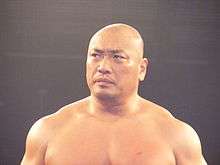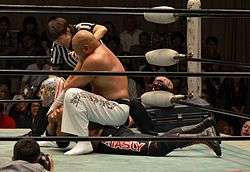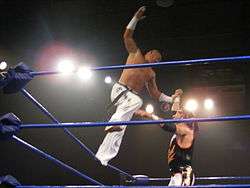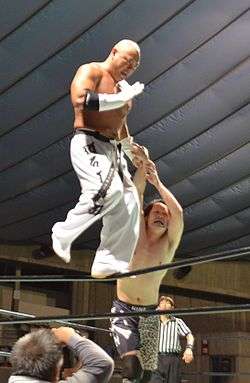Jinsei Shinzaki
 Shinzaki in April 2011. | |
| Birth name | Kensuke Shinzaki |
|---|---|
| Born |
December 2, 1966 Tokushima, Tokushima, Japan |
| Professional wrestling career | |
| Ring name(s) |
Hakushi Jinsei Shinzaki Mongolian Yuga Mr. Nihon Kamikaze |
| Billed height | 1.80 m (5 ft 11 in)[1][2] |
| Billed weight | 108 kg (238 lb)[1] |
| Billed from | Japan (as Hakushi)[1] |
| Trained by | Gran Hamada |
| Debut | November 19, 1992 |
Kensuke Shinzaki (新崎 健介 Shinzaki Kensuke, born December 2, 1966) is a Japanese professional wrestler and professional wrestling executive, better known by his ring name, Jinsei Shinzaki (新崎 人生 Shinzaki Jinsei). He is the president of the Michinoku Pro Wrestling promotion, as well as being the sole heavyweight wrestler on the roster. Shinzaki is also known for his appearances with other Japanese promotions such as All Japan Pro Wrestling, New Japan Pro Wrestling and Frontier Martial-Arts Wrestling and in the United States with the World Wrestling Federation from 1994 to 1996 under the ring name Hakushi.[1][3]
Professional wrestling career

Universal Lucha Libre (1992–1993)
A former soccer player, Shinzaki trained in amateur wrestling in high school. He firstly started working a career as an actor, but he left for professional wrestling when he met Gran Hamada. Shinzaki trained in the Mexican style of lucha libre before debuting in Hamada's promotion Universal Lucha Libre in 1992, wrestling under a mask and the name of Mongolian Yuga.
Michinoku Pro Wrestling (1993–1994)
In 1993, Shinzaki followed The Great Sasuke to his promotion Michinoku Pro Wrestling, becoming one of its founders. In June 1993, Kensuke unmasked and changed his gimmick, re-debuting as Jinsei Shinzaki ("Jinsei" meaning "life" in Japanese), an arukihenro or Buddhist pilgrim. Under this persona, Shinzaki wrestled in a slow, meditated style, and constantly performed prayers in the ring. He also came to the arenas in full pilgrimage garments, including white robes and suge-kasa hats, and carried a shakujo staff and a kongo-zue. Jinsei debuted as a silent heel, being introduced by Mr. Yamaguchi as a special member of Super Delfín's heel unit in order to "curse" The Great Sasuke with his prayers. However, after disagreements with them, Shinzaki turned face in 1994 and joined Sasuke and his allies.
In mid-1994, Shinazki wrestled on a World Wrestling Federation tour of Japan. This led to him being offered a contract with the promotion later that year.[4][5]
World Wrestling Federation (1994–1996)

In late 1994, Shinzaki traveled to the United States to wrestle for the World Wrestling Federation (WWF). He wrestled as Hakushi ("White Master"), a derivation of his Michinoku Pro Wrestling persona, a Buddhist pilgrim.[2] This new character resembled Jinsei Shinzaki, but he was characterized by sporting Buddhist shakyo written all over his skin, in a reference to Japanese folk character Hoichi the Earless. He was also accompanied by a facepaint-wearing cultist named Shinja. His first few matches were highlighted by victories over jobbers which included future star Matt Hardy and midcarders like Aldo Montoya, and 1-2-3 Kid.[6] Hakushi brought the wrestling style of lucharesu to the company, utilizing many aerial maneuvers as opposed to a single, established finishing move.
Hakushi had a brief alliance with ninja wrestler Kwang, calling themselves "Shogun",[3] but after losing a tag team match due to his fault, and Hakushi turned on him and defeated Kwang in the character's last appearance. Hakushi then got in a feud with former WWF Champion Bret Hart, wrestling a number of competitive matches against him.[6][7] He also famously had a three-way feud with perennial jobber Barry Horowitz and Bodydonna Skip. Horowitz, who lost for years on WWF programming to get over new talent, surprisingly used his three-quarter nelson to secure a victory over Skip.[6] Hakushi would also fall to Horowitz soon after because of interference from Skip. His loss was a surprise to the fans, not only given Horowitz's long time losing record, but also given how well Hakushi did during his feud with Bret Hart in what had been Hakushi's first major feud in the company. In Survivor Series, Hakushi was a member of The Underdogs team, but was eliminated after a kick from his enemy 1-2-3 Kid. He also was a competitor in the 1996 Royal Rumble, where by coincidence he was eliminated by Bret Hart's brother, Owen Hart.
During a match on Raw against Justin "Hawk" Bradshaw, Hakushi was hit by Bradshaw's branding iron after a loss.[6] That week on WWF Superstars, commentator Jim Ross reported that he had been so humiliated by the branding that he (kayfabe) left the WWF.[1][6]
New Japan Pro Wrestling (1996)
Upon leaving the his stint in WWF, Shinzaki returned to Japan. He made a single night appearance with New Japan Pro Wrestling at "Battle Formation" on April 29, 1996, where he wrestled The Great Muta. Shinzaki was introduced as a mystic, supernatural character very much like The Great Muta, who embodied evil while Shinzaki embodied good. Shinzaki was defeated in a spirited yet one-sided match.[8]
Michinoku Pro Wrestling (1996–1997)
Shinzaki returned to Michinoku Pro Wrestling in October 1996 at the Michinoku Pro 3rd Anniversary event, defeating Hayabusa. Once again aligning himself with The Great Sasuke, Shinzaki was undefeated in singles matches until 1997.
In October 1997, the Hakushi character was brought up to go against WWF's "Dead Man" The Undertaker. Hakushi was now an undead as well due to having been "killed" in his match with Muta, and was introduced in a coffin by an entourage of Japanese traditional pallbearers, showing in his clothes the same blood stains he had got in said match. He faced Undertaker, but was defeated after a Tombstone Piledriver and entombed in the mountains of Tohoku.[5]
Frontier Martial-Arts Wrestling (1997–1998)
In mid-1997, Shinzaki started appearing in Frontier Martial-Arts Wrestling helping Hayabusa in his battles against Mr. Gannosuke. They also had a brief stint in Extreme Championship Wrestling competing against Rob Van Dam and Sabu.
All Japan Pro Wrestling (1998–2002)
Shinzaki and Hayabusa competed in All Japan Pro Wrestling's Real Tag League 1998. In January 1999, they won the All Asia Tag Team Championship from Jun Izumida and Tamon Honda. They retained it until June 1996, when they lost it to Takao Omori and Yoshihiro Takayama. Shinzaki then kept a feud against Mitsuharu Misawa's Untouchables faction, but his appearances in AJPW became more sparse until ceasing in favour of Michinoku Pro in 2002.
In 2001, still as an AJPW representative, Shinzaki made a surprise appearance in New Japan Pro Wrestling, wearing a white mask and causing Kazunari Murakami's defeat to Keiji Mutoh. Jinsei then unmasked, and Mutoh introduced him as the new member of his personal faction Bad Ass Translate Trading.
Return to Michinoku Pro Wrestling (2002–present)
Shinzaki has been the president of Michinoku Pro Wrestling company since 2003 as a result of Sasuke dedicating more of his time to his political career as a member of the Iwate Prefectural (state) Assembly.
Shinzaki is also the co-founder of the joshi promotion Sendai Girls' Pro Wrestling along with joshi wrestler Meiko Satomura.
On April 15, 2011, Shinzaki returned to the United States to wrestle for Chikara in the 2011 King of Trios tournament, where he would represent Michinoku Pro with Dick Togo and the Great Sasuke. In their first round match Team Michinoku Pro defeated Team Minnesota (1-2-3 Kid, Arik Cannon and Darin Corbin).[9] The following day, Team Michinoku Pro defeated Jigsaw, Manami Toyota and Mike Quackenbush to advance to the semifinals of the tournament.[10] On April 17, Team Michinoku Pro was eliminated from the tournament in the semifinal stage by F.I.S.T. (Chuck Taylor, Icarus and Johnny Gargano).[11]
Personal life
Following the 2011 Tōhoku earthquake and tsunami, Shinzaki helped victims in the Tōhoku region by travelling around and providing them with food and drinks. Initial reports falsely noted that Shinzaki himself was living in his car due to losing his home and restaurant, however this was incorrect as he was really just spending a lot of time travelling to help the needy.[12]
In wrestling



- Finishing moves
- Koya Otoshi (Crucifix powerbomb preceded by a prayer)[3][13]
- Gokuraku-Gatame (Straight jacket camel clutch)[3][13][14]
- Nenbutsu Powerbomb (Sitout powerbomb preceded by a prayer)[3][13]
- Signature moves
- Asai moonsault preceded by a prayer
- Bronco buster[7]
- Cartwheel back elbow to a cornered opponent
- Cartwheel over the top rope suicide moonsault
- Chokeslam
- Diving headbutt preceded by a prayer[3][13]
- Diving senton preceded by a prayer
- Diving shoulder block preceded by a prayer[3]
- Handspring back elbow smash[3]
- High-angle corner slingshot into either a double foot stomp or a splash
- Mandala Hineri (Outward dragon screw)[13]
- Multiple kick variations
- Corner-to-corner missile drop
- Mule
- Rinne (Backflip)
- Super, sometimes preceded by a cartwheel evasion
- Ogami Watari (Arm twist ropewalk chop while praying)[13]
- Springboard splash
- Standing moonsault[3]
- Managers
- Nicknames
- Entrance music
- "Yamato Suite pt.1" by Musashi (MPW)
- "Angel" by Jim Johnston (WWF)
- "Sky, Wind, Fire, Water, Earth" by Wood Eye NO.1 (MPW)
Championships and accomplishments
- All Japan Pro Wrestling
- All Asia Tag Team Championship (1 time) – with Hayabusa
- Michinoku Pro Wrestling
- Tohoku Tag Team Championship (4 times) – with Último Dragón (1 time), Gaina (2 times), and Kesen Numajiro (1 time)
- Futaritabi Tag Tournament (1994) – with Super Delfin
- Michinoku Trios League (2005)[15] – with The Great Sasuke and Kesen Numajiro
- Pro Wrestling Illustrated
- PWI ranked him #209 of the 500 best singles wrestlers during the "PWI Years" in 2003[16]
- Tokyo Sports
- Newcomer of the Year Award (1993)
References
- 1 2 3 4 5 6 "Hakushi". WWE.com. WWE. Retrieved March 12, 2016.
- 1 2 Shields, Brian; Sullivan, Kevin (2009). WWE Encyclopedia. DK. p. 120. ISBN 978-0-7566-4190-0.
- 1 2 3 4 5 6 7 8 9 "OWOWprofile". Online World Of Wrestling. 2013-06-07. Retrieved 2013-07-07.
- ↑ James Dixon; Arnold Furious; Lee Maughan (2013). The Raw Files: 1994. Lulu.com. pp. 88–. ISBN 978-1-291-36600-6.
- 1 2 Johnson, Mike (January 21, 2007). "PWInsider Q&A — Undertaker in Japan". PWInsider.com. Retrieved March 13, 2016.
- 1 2 3 4 5 Cawthon, Graham (2013). the History of Professional Wrestling Vol 2: WWF 1990 - 1999. CreateSpace Independent Publishing Platform. ASIN B00RWUNSRS.
- 1 2 Ben Undelson (5 June 2013). Fiction. A Nostalgic Guide to Growing up with the WWF. Lulu.com. pp. 352–. ISBN 978-1-304-10190-7.
- ↑ New Japan “Battle Formation 1996”
- ↑ Radican, Sean (2011-05-04). "Radican's Chikara KoT Night 1 DVD Review 4/15 - Team Michinoku Pro vs. Team 1-2-3 Kid, Quackenbush & Toyota & Jigsaw vs. SAT's". Pro Wrestling Torch. Retrieved 2011-05-14.
- ↑ Radican, Sean (2011-05-13). "Radican's Chikara DVD review series - "King of Trios 2011 Night 2" 4/16: F.I.S.T. vs. Osaka Pro, RDV tournament, Quackenbush & Toyota & Jigsaw vs. Michinoku Pro". Pro Wrestling Torch. Retrieved 2011-05-14.
- ↑ Radican, Sean (2011-06-05). "Radican's Chikara DVD review series: "KOT 2011: Night 3 4/17 - Kid vs. Generico, Toyota vs. Eagles, KOT tournament Finals". Pro Wrestling Torch. Retrieved 2011-06-05.
- ↑ Autor Invitado (2011-03-21). "Luchador japonés necesita ayuda tras el terremoto en esa región". SuperLuchas Magazine. Retrieved 2011-03-21.
- 1 2 3 4 5 6 "Profile at Puroresu Central". Puroresu Central. Retrieved 2016-02-15.
- ↑ Shawn Armstrong. Wrestling Moves and Smashes Pocket Encyclopedia. Lulu.com. pp. 28–. ISBN 978-0-557-13462-5.
- ↑ "Michinoku Pro-Wrestling - "MICHINOKU TRIOS LEAGUE 2005"" (in German). PuroLove.com. Retrieved 2014-05-07.
- ↑ "Pro Wrestling Illustrated Top 500 of the PWI Years: 209 Jinsei Shinzaki". Pro Wrestling Illustrated. Blue Bell, Pennsylvania, United States: Sports and Entertainment publications LLC. May 21, 2003. p. 52. June 2003.
External links
- Hakushi on WWE.com
- Kensuke Shinzaki on IMDb